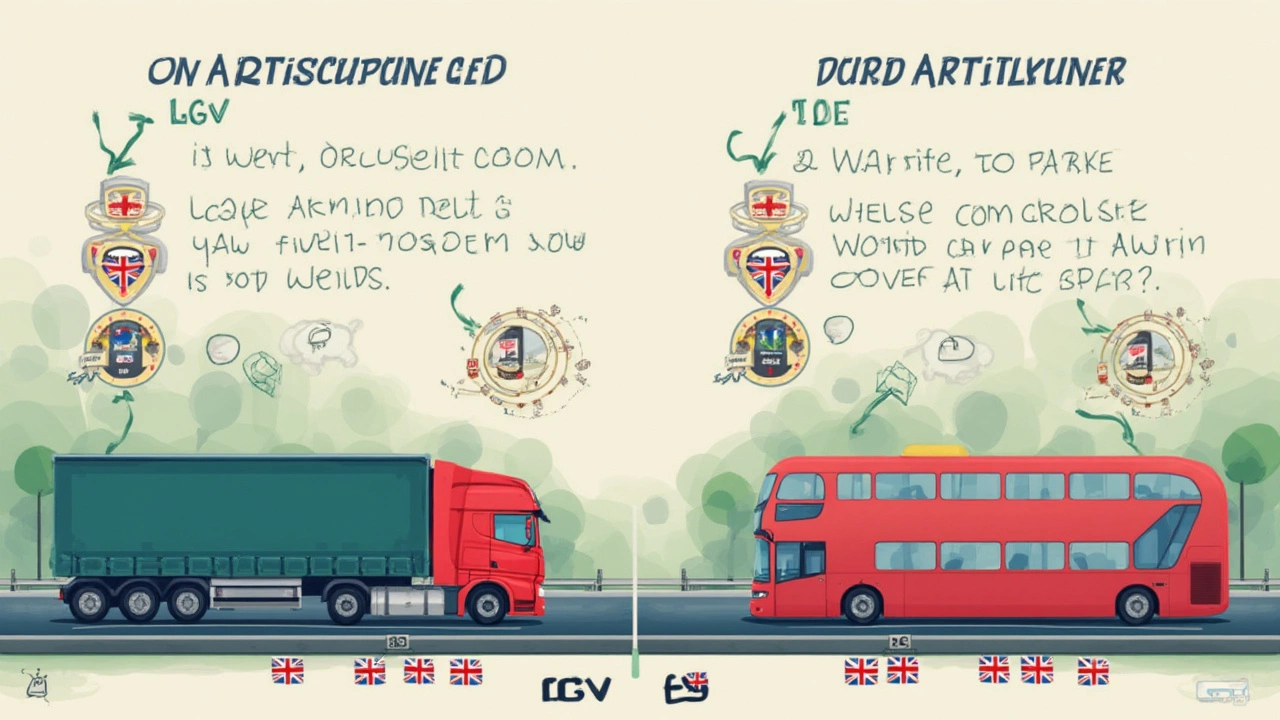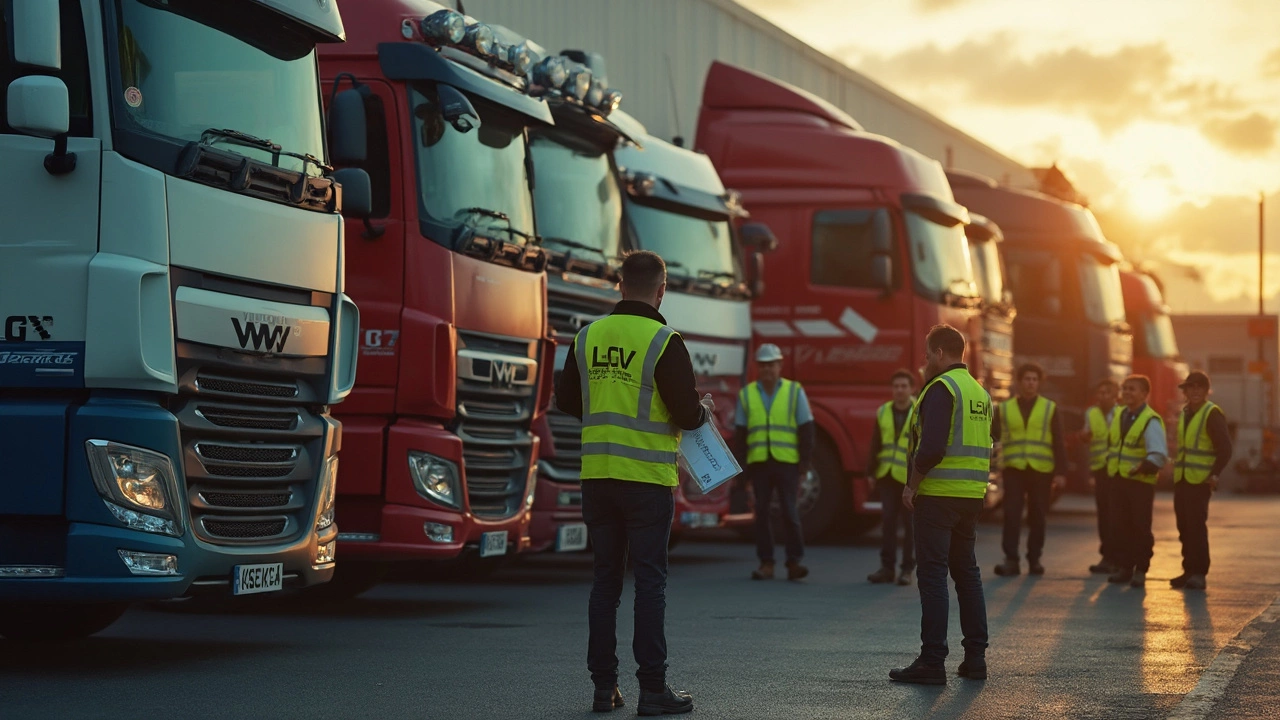Ever stared at the alphabet soup of LGV and PCV and wondered what on earth they actually mean? You’re definitely not alone. If you’re looking at HGV driving training, understanding these acronyms is the first step—before you even get near a steering wheel.
LGV stands for Large Goods Vehicle. It’s the label slapped on the trucks and lorries you see thundering down the motorway. PCV means Passenger Carrying Vehicle, which covers the likes of buses and coaches—anything built to move people, not cargo.
Mixing up the two could have you applying for the wrong licence or staring at training material that means nothing to your actual job goals. Each one needs its own licence, own set of rules, and a totally different kind of training. Getting these basics right saves you time, money, and a major headache down the road.
- Breaking Down the Acronyms: LGV and PCV
- Why the Difference Matters on the Road
- What Licences Cover Each Type
- Smart Tips for Getting Started in HGV Training
Breaking Down the Acronyms: LGV and PCV
If you’re new to HGV driving, these terms get tossed around like everyone already knows what they mean. LGV and PCV are used everywhere in the world of transport and licensing, but here’s what’s behind those confusing letters:
LGV stands for Large Goods Vehicle. In the UK, it refers to vehicles over 3.5 tonnes built for carrying goods. That includes things like delivery lorries, heavy articulated trucks, and even those massive supermarket wagons you see backing into tight spots. You might still hear some folks say HGV (Heavy Goods Vehicle), but after 1992, the official term in most licensing and road rules became LGV. Don’t let this old-school lingo trip you up—they mean basically the same thing here.
PCV stands for Passenger Carrying Vehicle. That’s your buses, minibuses, and coaches. Anything that carries people, not boxes. You’ll need a PCV licence if your job involves getting folks from A to B, whether it’s a tiny shuttle bus or a double-decker packed with tourists in London.
Here’s a simple breakdown so you can see the difference:
| Term | Stands for | What It Covers |
|---|---|---|
| LGV | Large Goods Vehicle | Lorries, trucks, articulated vehicles (over 3.5 tonnes) |
| PCV | Passenger Carrying Vehicle | Buses, coaches, minibuses |
If you plan to drive a goods vehicle, you only need to focus on LGV. If people are your cargo, PCV is your game. Sounds simple, but loads of would-be drivers spend months confused, signing up for the wrong thing. Notice that these acronyms are more than labels—they decide what kind of test you’ll take, what rules you learn, and who your future employers might be.
The bottom line: LGV is for stuff, PCV is for people. If you remember this, you’re already ahead of the pack.
Why the Difference Matters on the Road
The difference between LGV and PCV isn’t just some technical nitpick. Out on the road, it really matters—not just for your job, but for safety, legal reasons, and how you get trained. Both types of vehicles come with their own rules and challenges.
Let’s break it down. LGV drivers are moving heavy goods. These trucks and lorries handle way differently than cars or buses. Because they’re so big and heavy (sometimes up to 44 tonnes in the UK), stopping distances are way longer. Turning, reversing, even parking takes way more skill and focus. If something goes wrong, the risk to other road users is huge.
Now, when it comes to PCV, we’re talking about carrying passengers. It’s not just about handling a large vehicle—safety ramps up because you’ve got people relying on you. A full-sized London bus might cruise with 70 passengers on board. Those folks expect a safe, smooth ride, and the rules expect you to treat every single life like it's your own.
Here’s a quick snapshot to hammer it home:
| Vehicle Type | Main Focus | Biggest Responsibility |
|---|---|---|
| LGV | Goods/Cargo | Load security, road safety |
| PCV | Passengers | Passenger safety, smooth driving |
That’s why the law in the UK (and in most of Europe) keeps these licence categories separate. You can’t legally drive a double-decker bus with an LGV licence, just like you can’t haul freight with a PCV licence. Mix them up and you’re asking for fines, points on your licence, or even a court appearance.
So if you’re eyeing a new career, nail down which route fits you best. Each path means different training, different daily routines, and totally different ways to keep people and roads safe. It’s a lot more than just swapping seats—it’s taking on a responsibility that law, training providers, and real passengers or customers take seriously.

What Licences Cover Each Type
If you’re getting serious about LGV or PCV driving, you’ll need to know which licence is right for each job. This isn’t just about ticking a box—it’s what lets you legally drive the vehicle you want. So, let’s clear up each licence type.
For LGV (Large Goods Vehicle), you’ll be looking at a few main licence categories in the UK:
- Category C1: This lets you drive vehicles between 3.5 and 7.5 tonnes. Think delivery lorries or medium-size trucks.
- Category C: This is the standard licence for anyone looking to drive anything over 3.5 tonnes (most heavy trucks).
- Category C+E: This covers the big stuff—vehicles over 3.5 tonnes with a trailer over 750kg attached. If you want to be pulling an articulated lorry or an HGV with a trailer, this is you.
For PCV (Passenger Carrying Vehicle), the training and licence change up because it’s all about moving people:
- Category D1: This is for minibuses. You can drive vehicles with 9 to 16 seats, not counting your own.
- Category D: Want to drive a full-sized bus or coach? This is the one. Category D gives you the green light for any bus, big or small, with more than 8 passenger seats.
- Category D+E: Like with LGVs, adding the E means you can tow a trailer over 750kg behind your bus or coach.
Here’s a quick cheat sheet if you like things clear and simple:
| Type | Licence Category | Vehicle Examples |
|---|---|---|
| LGV | C1, C, C+E | Lorry, heavy truck, articulated lorry |
| PCV | D1, D, D+E | Minibus, bus, coach |
If you already have a car licence, you’ll need to pass the extra theory and practical tests for these HGV driving licences. Some drivers start with C1 or D1, just to get experience, then move to the larger stuff. If you’re aiming for that massive lorry or double-decker bus job, go straight for C+E or D.
One tip—always check which one your future job actually needs. No one wants to sit through pointless training when a quick check could save you a load of time and cash.
Smart Tips for Getting Started in HGV Training
So, you’re keen to break into the world of HGV driving and not sure where to start? There’s a lot more to it than just getting behind a big steering wheel. Here’s what you want to keep in mind to get rolling without hitting snags.
First, nail down exactly what you want to drive—LGV or PCV. This isn’t just a detail. If you want to haul goods, you’re in LGV country. If your dream is to ferry people around, PCV is your world. Don’t waste time and money on the wrong training course. Look up what jobs are actually available in your area—sometimes one is way more in demand than the other.
Next up is choosing your training centre. Not every place is the same. Check reviews. Ask locals or current drivers which trainers have a reputation for actually preparing you for the test, not just cashing in on your fees. The DVSA (Driver and Vehicle Standards Agency) has an online tool to find approved training providers. A solid centre helps with not just the test, but also job-hunting after you qualify.
Get your medical sorted as soon as you can. You need a D4 medical form signed by a doctor before you can even apply for the provisional licence. Loads of new drivers get delayed here, just waiting for an appointment. Some training centres can fast-track this, or suggest local doctors who handle it quickly and don’t charge a fortune. Worth asking about.
Here’s a quick look at the typical training timeline:
| Step | Time Needed | What You Do |
|---|---|---|
| Medical Check | 1 week | Doctor signs D4 form |
| Provisional Application | 2-3 weeks | Send in D2 & D4 forms to DVLA |
| Theory Training | 1-2 weeks | Study and book test |
| Practical Lessons | 1-4 weeks | Hands-on with an instructor |
| Practical Test | Depends on availability | Take the test, hopefully pass! |
Avoid the classic mistakes, like booking your practical test before you’re really ready. You’ll just pay again to rebook. Almost half of new drivers fail first time, mostly because nerves or simple mistakes. Do your lessons, take the mock tests your instructor offers, and focus on your weak spots.
Finally, always check if any funding help is out there, like local council grants or schemes from big logistics companies. These can cover part—or even all—of your course. The industry needs drivers, so support is out there if you hunt for it.
Stay focused and organised and you’ll be holding your new HGV driving licence before you know it. The step-by-step approach keeps you from spinning your wheels or blowing your budget.

